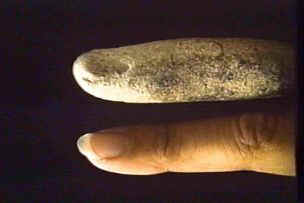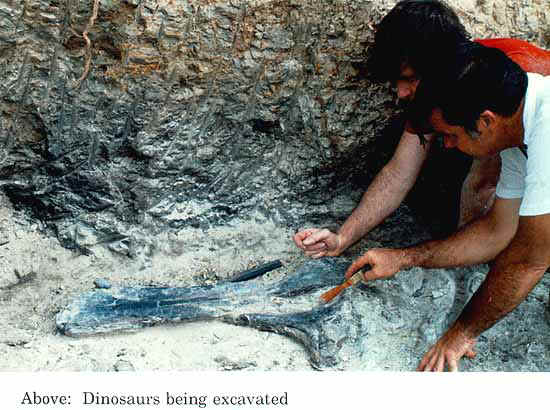Discussion of Finger Cast
|
Concern has been raised that a finger cast such as the one shown in the video, The Mysterious Origins of Man, could not be preserved, because skin would be the first to decay and the original outer shape of the finger would not be preserved. In other words, it looked too good to be true, therefore it must be a hoax, carved by a skilled sculptor.
Experiments done by forensic scientists studying the decomposition of human bodies have
shown that skin is one of the more resistant organs, while soft muscle tissue decomposes
rapidly. Human remains found in peat bogs tend to have excellently preserved skin,
even though the acid in the bogs dissolves the bone.
I am very familiar with examples of fossils as casts. It does not happen often, and
requires rapid burial or burial in an environment that inhibits rapid decay and/or pickles
the flesh, so to speak. The environment on those tidal flats was evaporitic (an
extreme environment), where shallow pools of sea water or rain water would shrink rapidly
under a hot tropical sun. Gypsum is very prevalent in many of the rock layers
(typical of marine evaporite environments). There was probably a high concentration
of salt in the water from evaporation, which produced a brine for interstitial water in
the carbonate mud. Salt was used by our forefathers to preserve meat.
Evaporation was not severe enough to produce salt crystals, however. The environment
was also alkaline as opposed to acidic, which means that bone would be preserved, although
perhaps partially replaced by other minerals.
The location where the finger cast was found was not given in the video, The Mysterious Origins of Man, which means that it was probably collected by an amateur who did not realize the importance of verification of source rock, and the need to preserve a piece of rock from which the cast came (if for no other reason than to show the mold or hole in that rock from which the cast was extracted). The nature of the finger cast (small and severed), the texture/color of the infilling sediment, and its similarity to an example of possible host rock (as shown in the video), implies that the sediment layer which contained the finger was deposited rapidly. Following deposition, the carbonate mud probably set up like pudding, eventually becoming hard like cement as evaporation removed water (that's why the Nevada salt flats make great pavement for testing high speed vehicles). With evaporation came an increase in salt and dolomite content, which would have slowed down the rate of decay. The layers on top of the footprint bed, which probably produced this fossil, contain calcite, dolomite, and gympsum spar, i.e. intergrown crystals that would have propped up the sediment and turned it into cement. The behavior of the mud when animals stepped in it and left their tracks is consistent with it being the consistency of pudding at the time the footprints were made.
Instead of the finger collapsing from outside in, gases from decay probably caused the
severed end to bloat (gas could easily exit there rather than through the skin), with the
eventual rupture of the sediment gel above. Once that happened, more liquefied
sediment from a subsequent flood or tidal incursion seeped in and filled the cast to
produce a mold around the bone.
The key is the size of the fossil, which is not large. A larger piece of decaying
body, such as that of a dinosaur, would not have been contained by the burial layer.
The body would have been exposed and rotted, the flesh disappearing, and the walls
of the containing sediment collapsing inwards. That is why the scapula of a
dinosaur, found in the same beds, is only represented by bone.
I have excavated whole mammals from muds layers in the Nebraska badlands, deposited
during an Oligocene flood
(http://www.monmouth.com/~bcornet/pictures.htm#Choose:).
|
|
The dog-like fossil I found was so quickly preserved, that its eye shape was
captured, along with some impressions of skin and muscle around the snout and head.
The rest of the body was too large, and its decay caused gas that ruptured containment,
and allowed later deposits of sediment to infill, but not before the body cast had
collapsed. The head remained entombed, because it was smaller, and the skull helped
to slow the rate of decay by filling most of the head cavity.
Note convex lens over eye cavity (actually a cavity or space), indicating preservation of
cast for some soft parts. Muscle ridges above the zygomatic arch can also be seen
preserved behind the eye. Such casts result from rapid burial.
Until I examine the finger cast, and can determine its authenticity, there will always be some doubt in my mind that it is genuine. Based on the above analysis, however, I suggest that it should be considered genuine until proven otherwise.
Bruce Cornet, Ph.D.
Date this page was last edited: 07/27/2004



